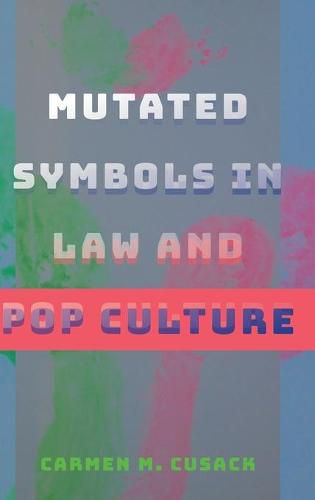Readings Newsletter
Become a Readings Member to make your shopping experience even easier.
Sign in or sign up for free!
You’re not far away from qualifying for FREE standard shipping within Australia
You’ve qualified for FREE standard shipping within Australia
The cart is loading…






This title is printed to order. This book may have been self-published. If so, we cannot guarantee the quality of the content. In the main most books will have gone through the editing process however some may not. We therefore suggest that you be aware of this before ordering this book. If in doubt check either the author or publisher’s details as we are unable to accept any returns unless they are faulty. Please contact us if you have any questions.
Mutated Symbols in Law and Pop Culture plays with iconic representations of fusion, liminality, dispossession, and development. Mutations embody life because they illustrate phases and progression. Mutations and mutants fascinate the public. They are depicted by artists, including James Franco, Cary Elwes, Sara Bareilles, The Smashing Pumpkins, Quvenzhane Wallis, Pablo Picasso, Alicia Keys, Katy Perry, Debbie Reynolds, Maddie Ziegler, the Olsen twins, Mark McGrath, and Paul Simon. This book discusses physiological manifestations of mutations, such as beauty and specialness (e.g., white tigers); aesthetic (e.g., redheads); innovation (e.g., Mormonism); and prowess (e.g., tuxedos). Mutated Symbols in Law and Pop Culture focuses on strata that are popularly contemplated in culture and by the law; for example, primordial states (e.g., sleep); supranatural physicality (e.g., bionic); irresistible impulse (e.g., psychopath); queer semantic shift (e.g., gay ); and class (e.g., Leo).
Mutated Symbols in Law and Pop Culture interweaves interdisciplinary analyses because mutations exceed defined ranges. For example, symbology and culture evocatively synergize in constitutional law. A symbol becomes legally protected if it is intended to communicate a particularized message that is likely to be understood by observers. This book demonstrates that mutations may not be sufficiently protected as speech. Even though the symbolism of mutations is the subject of study, the meaning of specific symbols may not be understood by the public. Symbols of mutation may identify cultural desires, embrace zeniths, and transform mundane or worn events into fantasies. Perhaps as a means of preserving, defending, and protecting mutations, culture has exhibited and spotlighted them.
$9.00 standard shipping within Australia
FREE standard shipping within Australia for orders over $100.00
Express & International shipping calculated at checkout
This title is printed to order. This book may have been self-published. If so, we cannot guarantee the quality of the content. In the main most books will have gone through the editing process however some may not. We therefore suggest that you be aware of this before ordering this book. If in doubt check either the author or publisher’s details as we are unable to accept any returns unless they are faulty. Please contact us if you have any questions.
Mutated Symbols in Law and Pop Culture plays with iconic representations of fusion, liminality, dispossession, and development. Mutations embody life because they illustrate phases and progression. Mutations and mutants fascinate the public. They are depicted by artists, including James Franco, Cary Elwes, Sara Bareilles, The Smashing Pumpkins, Quvenzhane Wallis, Pablo Picasso, Alicia Keys, Katy Perry, Debbie Reynolds, Maddie Ziegler, the Olsen twins, Mark McGrath, and Paul Simon. This book discusses physiological manifestations of mutations, such as beauty and specialness (e.g., white tigers); aesthetic (e.g., redheads); innovation (e.g., Mormonism); and prowess (e.g., tuxedos). Mutated Symbols in Law and Pop Culture focuses on strata that are popularly contemplated in culture and by the law; for example, primordial states (e.g., sleep); supranatural physicality (e.g., bionic); irresistible impulse (e.g., psychopath); queer semantic shift (e.g., gay ); and class (e.g., Leo).
Mutated Symbols in Law and Pop Culture interweaves interdisciplinary analyses because mutations exceed defined ranges. For example, symbology and culture evocatively synergize in constitutional law. A symbol becomes legally protected if it is intended to communicate a particularized message that is likely to be understood by observers. This book demonstrates that mutations may not be sufficiently protected as speech. Even though the symbolism of mutations is the subject of study, the meaning of specific symbols may not be understood by the public. Symbols of mutation may identify cultural desires, embrace zeniths, and transform mundane or worn events into fantasies. Perhaps as a means of preserving, defending, and protecting mutations, culture has exhibited and spotlighted them.